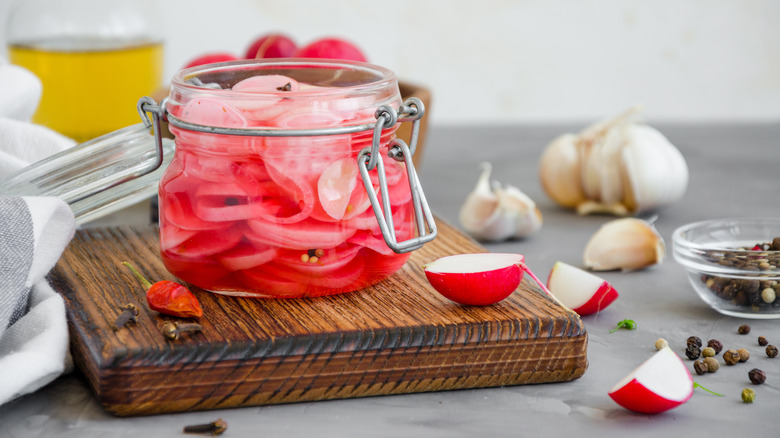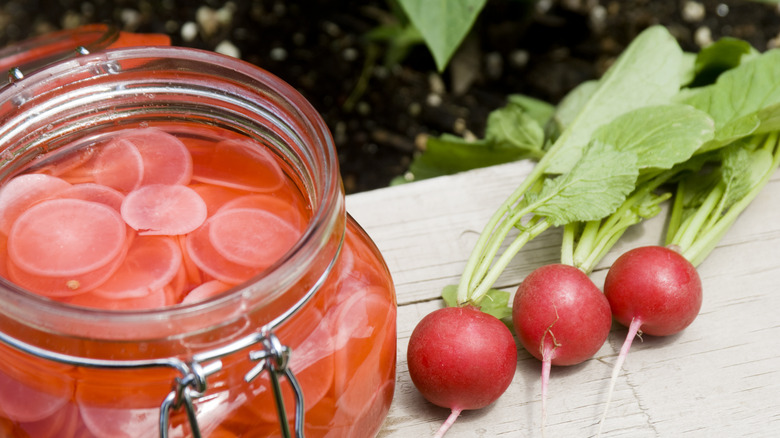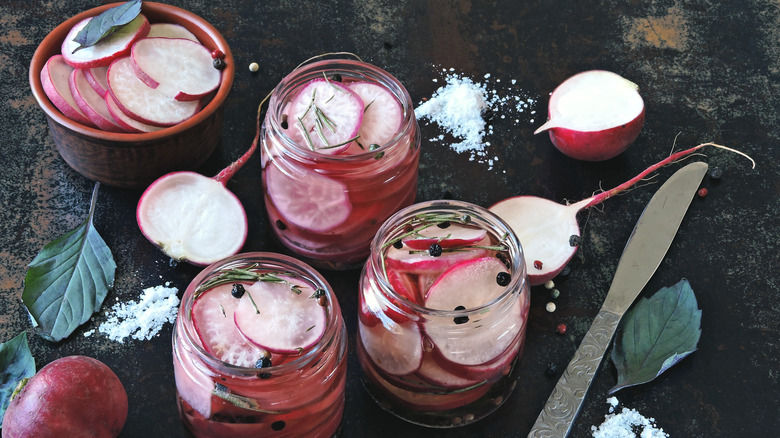How Long Do Pickled Radishes Last In The Fridge?
Whether it's the quintessential cucumber or the more unusual potato, pickled foods are the definition of versatile and delicious. To those of us whose mouths water when we think of a crisp veggie soaked in acidic vinegar (and are maybe addicted to collecting jars in our fridges), it seems like there's not a single vegetable or fruit that couldn't be kicked up with a zesty brine. Among the many foods you can pickle, there's one choice that's a classic, yet somewhat underrated: radishes.
Fresh radishes are sharp, peppery, and refreshing, and while they're delicious on their own, once they've been pickled, they take on a tangy, slightly sweet, and downright delicious flavor. Their pinkish-red hue is also a defining trait that can spruce up any dish with a pop of vibrant color. Like all pickled foods, these radishes also last a long time, but unfortunately, they don't stay at the peak of freshness forever.
While you don't have to worry about them going bad quickly, if you store them properly in the fridge, pickled radishes lose their fresh crunch and tantalizing flavor over time. They can become soft and soggy, with a more dull taste. Homemade pickled radishes last up to six months in the refrigerator, but are best enjoyed within three months. Store-bought pickled radishes might have a similar lifespan, but it's best to consult the label on the jar for storage guidelines.
Properly storing pickled radishes
Storing pickled radishes is as easy as finding an open spot for them in your refrigerator, right? Technically, yes. However, there are some best practices to maximize their shelf life. For starters, store your pickled radishes in an airtight container, such as a mason jar or a food-grade plastic container, to maintain freshness and prevent contamination. Secondly, make sure each pickled radish, whether sliced or whole, is fully submerged in the pickling liquid to prevent air exposure. Oxidization can facilitate spoilage.
If necessary, add more pickling liquid to cover the radishes whenever you notice the liquid in the jar is getting low. Avoid keeping the lid off of your airtight container for extended periods, as more time exposed to air means more time exposed to potentially harmful bacteria and pathogens. And although it sounds elementary, keep the pickled radishes away from raw meats, seafood, and other foods that can cross-contaminate other products in your refrigerator.
Store your radishes on a separate shelf or in a designated area for produce, and only remove them from the jar with clean utensils to prevent further cross-contamination. Finally, your refrigerator should be set to at least 40 degrees Fahrenheit or cooler to keep all foods, including pickles, fresh and safe to eat.
Recognizing signs of spoilage in pickled radishes
Although the preservation process can great slow the growth of bacteria on virtually any pickled food, pickled radishes can become dangerous to eat. To tell if your radishes have gone south, rely on your senses. First is the eye test. If the brine is excessively cloudy, it may indicate spoilage or the presence of microbial activity. Slimy textures or extreme color changes are other telltale signs of spoiled pickled radishes, as is the presence of mold.
If you notice bubbles or gas formation in the pickling liquid, it may indicate that the veggies have started to ferment too much, or perhaps the presence of undesirable microorganisms. While bubbles are normal in lacto-fermented pickles, excessive gas production is a sign of spoilage. Next up is the smell test. Pickled radishes can smell sharp and a bit funky, but they should never smell rancid, musty, or like soured vinegar. If you get whiffs of anything that makes your eyes water, ditch the radishes.
It's best to avoid performing a taste test on your radishes, since you could end up accidentally consuming mold or harmful bacteria, so let your eyes and nose call the shots. Pickled radishes are some of the most versatile and delicious pickled veggies you can make, and as long as you keep them sealed tightly and put them in the right place in your fridge, you'll have refreshing, crunchy pickles for quite a while.


